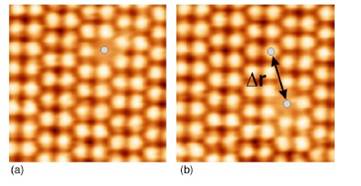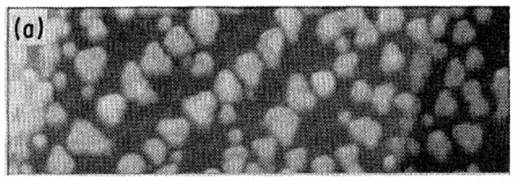Structure formation in heteroepitaxial systems: Co on Ag/Cu/Au
In recent years, thousands of applications have been designed by using the invention of new materials. With such kinds of new materials, human life has become more modern, more convenient, and more effective. Therefore, the more we know about material structure, mobility of atoms, adatoms, and vacancies, the more detail we learn about the characteristics of materials.

The vacancy displacement (r) with respect to the initial position for different times: (a) t=0; (b) t=108 s at 312K on Ge (111)-c (2x8) [2]
By using a fast Scanning Tunneling Microscopy , "fast - STM"; that has 1,000,000 pixels / sec [1] - scan speed and that operates in the range of temperature from 90K - 350 K, we aim to measure the diffusion of single vacancy from low to high temperature (figrure 1) [2] and compare the results to theoretical results. Later on, we will create homoepitaxial systems by laser ablation and investigate the diffusion of very small clusters.

0.8-ML Co coverage on Au(111) (110 X 40 nm ) [3]
Furthermore, we intend to deposit Co on Ag/Cu/Au (figure 2) [3] by using the Molecular Beam Epitaxy, "MBE", method to create heteroepitaxial systems at low temperature and study detailed structures, and morphological changes by increasing the temperature of those heteroepitaxial systems. Finally, the structure changing of such systems will be investigated under an influence of O2 and H2 gases.
In conclusion, fast STM measurements of systems which are mentioned above will help us to identify more information about the topographic structures of such surfaces. With the results of such studies more effective materials and more useful equipments can be invented to contribute to the development of mankind.
[1] http://www.specs.de/cms/upload/PDFs/SPECS_Prospekte/Aarhus_SPM_Family_Prospekt_2.pdf
[2] I. Brihuega, O. Custance, and J. M. Gómez-Rodríguez, Phys. Rev. B 70, 165410 (2004)
[3] Bert Voigtländer, Gerhard Meyer, and Nabil M. Amer, Phys. Rev. B 44,18 (1991).
Quang Huy Vu
Ruhr University of Bochum

